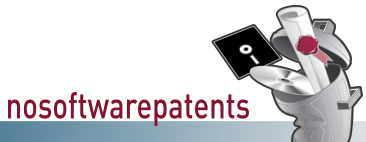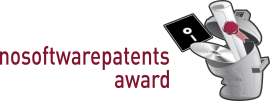| English | Deutsch |

![- Logo]](../images/layout007-small.png)
| Home |
| Software Patent of the year 2006 |
| About |
| Supporters |
| Background |
| News |
| Press November |
| Links |
| Contact |
| Imprint |
July – Patent 3
- EU-Patent on software respectively a logical method (algorithm)
- Application to European Patent Office on 16/12/1991 by EDICO S.r.l. (Italy)
- Granted on 11/6/1997
- Date of priority: 21/12/1990 (valid no more than until 21/12/2010)
- Patent attorney: Eisenführ, Speiser & Partner
- Appeal filed on 10/3/1998 by Interessengemeinschaft für Rundfunkrechte GmbH (Germany) on grounds of lacking patentability according to article 100 EPC and on grounds of articles 52 to 57 EPC (lacking inventive step regarding the state of the art)
- Result of the appeal: modification of the patent on 22/8/2003
- Patent specification provided by FFII/Gauss
- Patent specification provided by EPO/espacenet
- Access to records provided by EPO/epoline
- The decisive element are the claims, as they specify which actions are forbidden within the framework of the patent.
- Violating one single claim is sufficient to be considered a patent violation. Generally, claim number 1 is the decisive main claim which covers all other claims relating to special cases.
- The description is intended to help the reader interpret the claim. At the same time, it is supposed to document and disclose the details of the invention. This disclosure is the original purpose of the entire patent system.
- In practice, a patent specification contains no detailed information on how the patented procedure could be implemented (even if the patent owner allowed the implementation). In particular, a software patent contains no program code (reference implementation), but merely describes the idea of a software.
Patented idea: Switching a television signal receiver to a certain channel as soon as a certain television programme is broadcast on this channel.
Main claim: A television signal receiver tuned in on channel A is automatically switched to another channel B, as soon as on the latter there is broadcast a particular, previously specified programme or as soon as the programme on channel B is changed.
The original version of the patent specified "television signal selection device" without the requirement that first of all channel A must be set. As a response to the appeal "television signal selection device" was replaced for "television signal receiver" and the requirement mentioned above was added.
Further claims:
- Identifying the beginning of a television programme on channel B by means of a second set of the necessary components of the television signal receiver
- Controlling the change of channels through a control circuit which may include a micro processor
- Identifying the specified programme by means of the signals provided for this purpose in the broadcasting in particular VPS
- Switching on at the push of a button
- Asking the user fort the programme to be switched on
- Using the television screen fort he display (on screen display)
- Implementation by means of hardware circuits or software
The claims include a number of apparently technical expressions like "signal comparator" or "cabled logic". However the innovation comprises the plainly logical association "IF the programme begins on another channel THEN switch on to this programme in order to....". Irrespective of the realisation by means of a computer programme or hardware circuits a logic patent – respectively a software patent – is involved.
Description: Television viewers sometimes do not want to miss a certain programme while they are watching another programme on another channel. The patent specification documents and monopolises a solution for this problem. This solution is superior to a repeated manual switchover of television programmes or a faded in miniature display of another programme.
Furthermore the patent specification documents that the keys of remote control devices are allocated in ways easily remembered (e.g. in Italy key "1" for the channel RAI 1, key "2" for RAI 2 etc.) and that hence it will be easier for viewers to use the switchover automatic if the programming of the switchover happens by means of such keys plus an additional key.
Everyday parallel: A father and his son want to watch a football match broadcast on channel B. Prior to this the channel B broadcasts a music programme the son is interested in. However until the match begins the father wants to watch a political discussion broadcast on channel A and advises his son ("switchover automatic "): "Go into your room and watch channel B on the small television. At the same time I am watching channel A on the big television. As soon as the match begins you return and switch over the big television on to channel B."
Examples for patent infringements:
- The patent-infringing switchover automatic refers to every television software applying VPS. This is the case irrespective of whether the software is used with a television or a standard computer.
- A video tape recorder is also a television receiver and by connecting it to a monitor it can be used like a television – with or without videotaping. VPS-programming of the video tape recorder effects a switchover to another channel and consequently infringes the patent.
| Previous Software Patents of the Month |
| > September |
| > August |
| > July |
| Patent 1 | |
| Patent 2 | |
| Patent 3 | |
| Patent 4 | |
| Patent 5 |
| > June |
| > May |
| > April |
| > March |
| Press Archive |
| > Oktober |
| > September |
| > August |
| > July |
| > June |
| > May |
| > April |
| > March |
